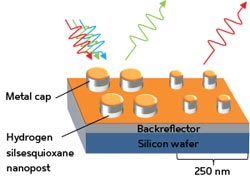Nanotechnology: Color printing reaches new highs

Variation in post size and spacing in the metal array alters which incoming wavelength of light (red, green or blue) is reflected back.<br><br>Reproduced from Ref. 1 © 2012 K. Kumar et al.<br>
Commercial laser printers typically produce pin-sharp images with spots of ink about 20 micrometers apart, resulting in a resolution of 1,200 dots per inch (dpi). By shrinking the separation to just 250 nanometers — roughly 100 times smaller — a research team at A*STAR can now print images at an incredible 100,000 dpi, the highest possible resolution for a color image1. These images could be used as minuscule anti-counterfeit tags or to encode high-density data.
To print the image, the team coated a silicon wafer with insulating hydrogen silsesquioxane and then removed part of that layer to leave behind a series of upright posts of about 95 nanometers high. They capped these nanoposts with layers of chromium, silver and gold (1, 15 and 5 nanometers thick, respectively), and also coated the wafer with metal to act as a backreflector.
Each color pixel in the image contained four posts at most, arranged in a square. The researchers were able to produce a rainbow of colors simply by varying the spacing and diameter of the posts to between 50 nanometers and 140 nanometers.
When light hits the thin metal layer that caps the posts, it sends ripples — known as plasmons — running through the electrons in the metal. The size of the post determines which wavelengths of light are absorbed, and which are reflected (see image).
The plasmons in the metal caps also cause electrons in the backreflector to oscillate. “This coupling channels energy from the disks into the backreflector plane, thus creating strong absorption that results in certain colors being subtracted from the visible spectrum,” says Joel Yang, who led the team of researchers at the A*STAR Institute of Materials Research and Engineering and the A*STAR Institute of High Performance Computing.
Printing images in this way makes them potentially more durable than those created with conventional dyes. In addition, color images cannot be any more detailed: two adjacent dots blur into one if they are closer than half the wavelength of the light reflecting from them. Since the wavelength of visible light ranges about 380–780 nanometers, the nanoposts are as close as is physically possible to produce a reasonable range of colors.
Although the process takes several hours, Yang suggests that a template for the nanoposts could rapidly stamp many copies of the image. “We are also exploring novel methods to control the polarization of light with these nanostructures and approaches to improve the color purity of the pixels,” he adds.
The A*STAR-affiliated researchers contributing to this research are from the A*STAR Institute of Materials Research and Engineering and the A*STAR Institute of High Performance Computing
Journal information
Kumar, K., Duan, H., Hegde, R. S., Koh, S. C. W., Wei, J. N. & Yang, J. K. W. Printing colour at the optical diffraction limit. Nature Nanotechnology 7, 557–561 (2012).
Media Contact
All latest news from the category: Materials Sciences
Materials management deals with the research, development, manufacturing and processing of raw and industrial materials. Key aspects here are biological and medical issues, which play an increasingly important role in this field.
innovations-report offers in-depth articles related to the development and application of materials and the structure and properties of new materials.
Newest articles

High-energy-density aqueous battery based on halogen multi-electron transfer
Traditional non-aqueous lithium-ion batteries have a high energy density, but their safety is compromised due to the flammable organic electrolytes they utilize. Aqueous batteries use water as the solvent for…

First-ever combined heart pump and pig kidney transplant
…gives new hope to patient with terminal illness. Surgeons at NYU Langone Health performed the first-ever combined mechanical heart pump and gene-edited pig kidney transplant surgery in a 54-year-old woman…

Biophysics: Testing how well biomarkers work
LMU researchers have developed a method to determine how reliably target proteins can be labeled using super-resolution fluorescence microscopy. Modern microscopy techniques make it possible to examine the inner workings…





















